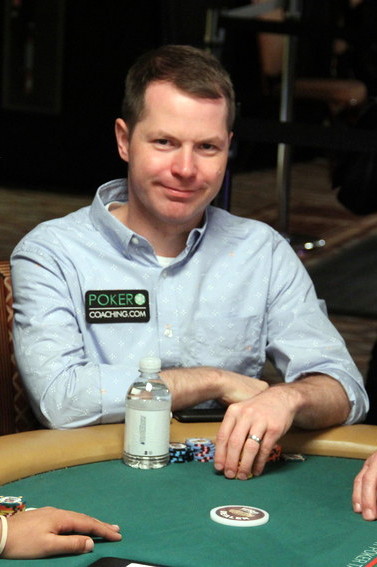






Overplaying Acesby Jonathan Little | Published: Feb 09, 2022 |
|
|

Jonathan Little
In a $1-$3 cash game with $300 stacks, our Hero raised to $12 with A A
A from early position, which is perfectly fine. The hijack, cutoff, button, and big blind called.
from early position, which is perfectly fine. The hijack, cutoff, button, and big blind called.
The flop came J J
J 6
6 and the big blind checked. Our Hero bet $40 into the $60 pot.
and the big blind checked. Our Hero bet $40 into the $60 pot.
While this value bet may seem fine, it is actually a substantial mistake because the sum of his opponents’ ranges all contain many jacks. While aces could certainly be best at the moment, almost no worse hands will call a $40 bet unless the opponents are extreme calling stations.
Hero should instead check, looking to check-call if one player bets and everyone else folds, or even check-fold against a bet and a call or raise. While this may seem overly cautious, it is important to realize that when someone calls or raises a flop bet on a paired board in a multi-way pot, they must have something that is decently strong. The flop bettor could of course also have a strong hand.
This is a situation where Hero has extreme reverse implied odds, meaning he will either win a small pot or lose a large one. It is often best to avoid these situations.
 This time, the cutoff called Hero’s $40 flop bet and everyone else folded. The turn was the 5
This time, the cutoff called Hero’s $40 flop bet and everyone else folded. The turn was the 5 . Hero bet $80 into the $140 pot.
. Hero bet $80 into the $140 pot.
This is another substantial mistake. Hero wrote in the comments that he “knew” the opponent would always raise the flop with trips, so aces must be the best hand. The problem with this line of thought is that Hero actually has little to no idea of how his opponent will respond to a large flop bet with trips. Realize that just because you would raise with trips does not mean that your opponents will. Also realize that when you bet large on the flop, from a GTO point of view, your opponent is incentivized to mostly call and rarely raise. Hero has no real reason to remove trips from the opponent’s range. Hero should have likely checked the turn, looking to check-call, although it is a tough spot.
The cutoff called Hero’s $80 turn bet. The river was the 2 , and our Hero went all-in for $168 into the $300 pot.
, and our Hero went all-in for $168 into the $300 pot.
This is again a mistake, although perhaps less of a mistake than on the previous betting rounds. If the cutoff happens to have a hand like pocket tens, he may call the all-in but will check behind if Hero checks, and there are likely no potential bluffs in the cutoff’s range that may bluff if checked to, so going for thin value has at least some merit. That said, check-folding could easily be best if Hero is now sure that the cutoff has mostly trips (which is probably the case).
The cutoff called with J-10 and stacked Hero. Hero thought it was a bad beat, but in reality, he played the hand about as poorly as possible. Instead, he should have checked the flop. Most likely, the cutoff would have bet. If someone else called, Hero could have folded immediately or perhaps called and then check-folded the turn, allowing him to get off the hook.
Even if everyone else folded to the cutoff’s flop bet, Hero would be much happier check-calling because then the cutoff would have numerous potential bluffs in his range that may continue betting the turn. As played though, Hero essentially forced the cutoff to have a better hand than the aces, which is a blunder that will make it difficult for Hero to ever win money from poker.
 Jonathan Little is a two-time WPT champion with more than $7 million in live tournament earnings, best-selling author of 15 educational poker books, and 2019 GPI Poker Personality of the Year. If you want to increase your poker skills and learn to crush the games, check out his training site at PokerCoaching.com/cardplayer.
Jonathan Little is a two-time WPT champion with more than $7 million in live tournament earnings, best-selling author of 15 educational poker books, and 2019 GPI Poker Personality of the Year. If you want to increase your poker skills and learn to crush the games, check out his training site at PokerCoaching.com/cardplayer.
Features
Tournaments
Strategy
Commentary & Analysis